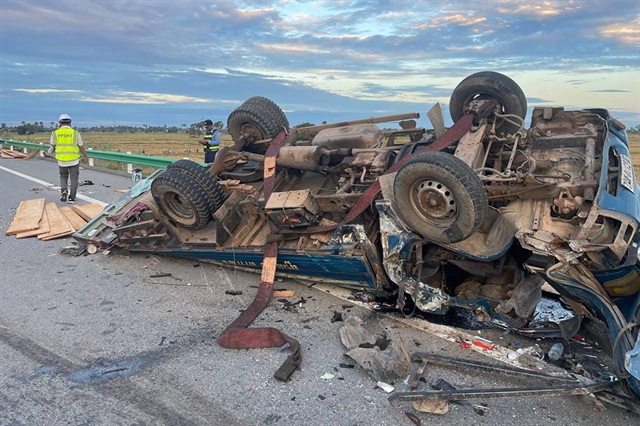 World
World

 |
| A truck overturned in Cambodia's Kampong Speu Province on December 15, 2024, killing one and injuring several others. — Photo courtesy of Kampong Speu Provincial Police |
PNHOM PENH — The twelve months of 2024 saw a five per cent decrease in fatal traffic accidents in Cambodia, with 1,509 people losing their lives on the Kingdom’s roads, a drop of 81 from the 2023 figures.
Road safety experts have urged strict, transparent enforcement of the law, along with increased public education and nationwide funding to ensure a sustainable decline in the road toll.
Phorn Rim, spokesperson for the Cambodian Ministry of Public Works and Transport, reported that an average of four people died in road traffic accidents per day in 2024. The primary causes were recording as excessive speed and a failure to respect traffic laws.
From January 1 to December 31, there were 2,844 road traffic accidents recorded, resulting in 1,509 deaths, 2,273 serious injuries and 1,447 minor ones. Among those involved, 2,477 individuals were not wearing helmets.
When comparing 2024 to 2023, accidents decreased by some 473 cases (14 per cent). Deaths fell by 81 (5 per cent), serious injuries by 493 (18 per cent), minor injuries by 302 (17 per cent), and cases involving motorcyclists without helmets fell by 596 (19 per cent).
According to the transport ministry, the leading causes of accidents were speed (1,156 cases, 40.6 per cent), failure to respect right-of-way (649 cases, 23 per cent), improper lane changes (268 cases, 9.4 per cent), and reckless turning (221 cases, 8 per cent). Other contributing factors included risky overtaking (215 cases, 7.6 per cent), vehicle defects (114 cases, 4 per cent) and driving under the influence (105 cases, or just 3.7 per cent).
Kim Pagna, country director of the Asia Injury Prevention Foundation (AIP), described the reduction in accidents as a positive outcome, which reflected Cambodia's efforts to reduce traffic accidents.
“This decline, while promising, shows there’s more to do. The trend of decreasing fatalities and injuries year-on-year is something we strive for, ensuring continued progress,” he said.
He noted fluctuations in traffic accident trends: after significant achievements in 2016-2018, incidents surged in 2019.
Efforts in 2020 and 2021 led to reductions, but incidents rose again in 2022 before declining in 2023 and 2024.
Pagna expressed optimism, stating that with intensified efforts and the implementation of key measures, Cambodia could further reduce fatalities and injuries, potentially achieving its 2030 goal of limiting traffic deaths to 1,229 annually.
To sustain progress, he emphasised the importance of consistent law enforcement with fairness and transparency, public education on traffic safety starting in schools and increased government investment.
He highlighted the need to address challenges for motorcyclists, who accounted for 70-80 per cent of fatalities, with a significant proportion of victims not wearing helmets, particularly at night and in rural areas.
Pagna also suggested technical training for motorcyclists, especially overrepresented groups such as workers, farmers and students, and advocated for license requirements for riders of motorcycles with engines up to 125cc.
In addition, he recommended improving road safety infrastructure, such as signage, lane markers and vehicle inspections, while encouraging the import of vehicles with high safety standards and improvements to emergency healthcare services.
Cambodia’s 10-year National Road Safety Action Plan requires over US$120 million in funding. He urged increased government investment, private sector involvement and support from development partners to ensure the plan’s success.
“Our plan is very good, but the main problem is that we lack the funds to implement the entire plan. I urge the government to increase investment in road safety work as in other areas,” he said.
He also encouraged private sector philanthropists and development partners to get involved in implementing the action plan.
The transport ministry has committed to improving road safety by inspecting high-risk areas and implementing additional safety measures, such as distributing helmets and educating road users.
Efforts by civil society and private entities, such as adopting internal traffic safety policies within schools and factories, have shown promising results in reducing accidents and fostered a culture of safety, added Pagna. THE PHNOM PENH POST/ANN




